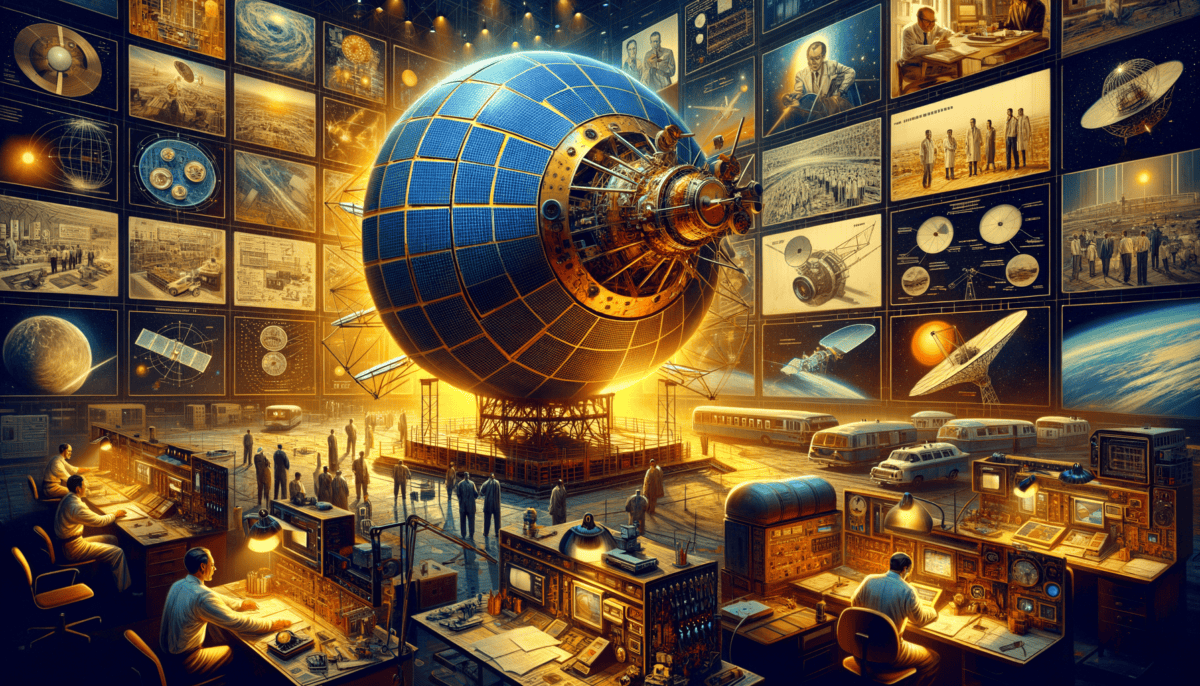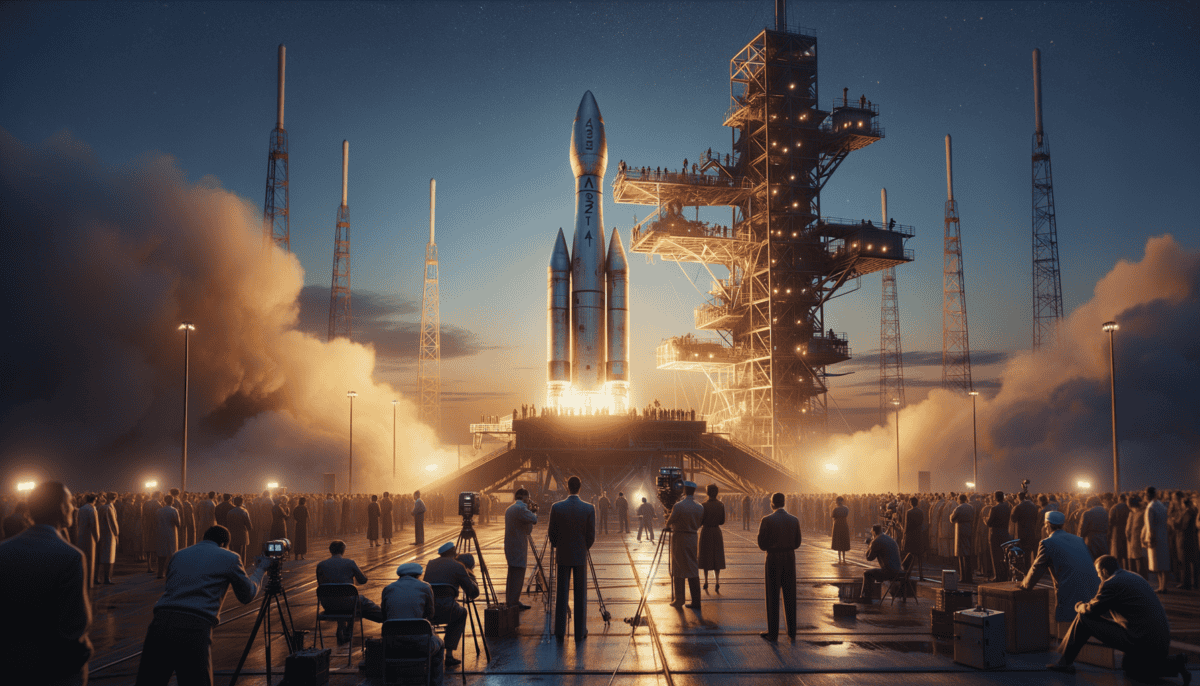A Race to the Stars
The year was 1957. On a chilly October night, a tiny dot of light moved across the sky. It was Sputnik, the first human-made satellite. This small metal ball changed everything!
"Look up there!" shouted Tommy, a young boy in New York. "Is that really from Russia?"
His dad nodded. "Yes, son. The Russians put that satellite in space before we did."
In America, scientists and leaders were worried. They didn't want Russia to be ahead in space. President Eisenhower knew they had to do something big. He called the best scientists in the country.
"We need to catch up," he said. "And we need to do it fast!"
The Big Dream
Dr. John Pierce from Bell Labs had a wonderful idea. He dreamed of putting special satellites in space that could help people talk to each other across the whole world!
"Right now, phone calls can't go very far over the ocean," he explained to his team. "But if we put a satellite up high, it could bounce signals from one place to another!"
Some people thought his idea was silly. Back then, phones needed wires to work. How could they make calls through space?
Making Plans
Scientists started drawing pictures of what their satellite might look like. They wanted to make something special – not just any satellite, but one that could send TV shows and phone calls across the ocean!
"We'll call it Telstar," said Dr. Pierce with a smile. "It will change how people talk to each other forever."
• They were very simple
• Most only sent beeping signals
• None could send TV shows or phone calls
• They didn’t last very long in space
Working Together
The best part was how everyone worked together. Scientists from NASA joined with people from telephone companies. Engineers spent long hours solving hard problems.
Little Sally, whose mom worked at Bell Labs, asked one day, "Why are you working so late, Mommy?"
Her mom smiled. "Because we're building something that will help people all over the world talk to each other. Isn't that exciting?"
A New Hope
Every day, more people joined the project. They built special rooms with giant antennas to talk to the satellite. They tested new ways to make power from the sun. They worked hard to make everything perfect.
"Will it really work?" asked many people.
"We'll make it work," said the scientists. "We have to try!"
The race was on, but this wasn't just about beating Russia anymore. It was about bringing people together. It was about making something that would help everyone on Earth.
As the sun set each day, the teams kept working. They knew that soon they would try something that had never been done before. They would send their very own star into the sky – a star that would help connect the whole world.
Through the windows of Bell Labs, workers could see the real stars twinkling above. Soon, their Telstar would be up there too, helping to make the world a smaller, friendlier place.
Building Tomorrow’s Star
At Bell Labs, the morning sun peeked through tall windows. Engineers rushed around with excited faces. They were building something amazing – Telstar! ️
“What makes Telstar special?” asked Jimmy, a young visitor whose dad worked at the lab.
“It’s like a mirror in the sky,” smiled Dr. John Pierce. “But instead of reflecting light, it reflects TV shows and phone calls!”
Smart Ideas
The team at Bell Labs had big dreams. They wanted to make phone calls zoom across the ocean through space! But they had lots of problems to solve first.
“How will we give it power?” asked one engineer.
“The sun will help us!” said another. “We’ll cover it with special panels that turn sunlight into electricity.” ☀️
Working Hard
Every day brought new challenges. The satellite needed to be strong but light. It had to survive in space where it’s very hot and very cold.
“It’s like building a tiny spaceship,” explained Sarah, one of the engineers. “Everything has to be perfect!”
• Catch signals from Earth
• Send signals back
• Use solar power
• Spin just right
• Stay working in space
Money Matters
Building Telstar wasn’t cheap! AT&T spent lots of money – more than anyone had ever spent on a satellite before.
“Why spend so much?” people asked.
“Because connecting people is worth it,” said the project leader. “Think about calling your grandmother in Europe as easily as calling next door!”
Team Spirit
The best part was how everyone helped each other. Scientists shared their ideas. Engineers fixed problems together. Even the cleaning staff felt excited about the project!
“Look what I drew!” said little Maria, showing her dad’s coworker a crayon picture of Telstar.
“That’s beautiful!” smiled the engineer. “Maybe you’ll help build satellites someday too!”
Testing Time
Before sending Telstar to space, they had to test everything. They put it in special rooms that were very hot, then very cold. They shook it to make sure nothing would break.
“Is it ready yet?” asked an eager young intern.
“Almost,” said Dr. Pierce. “We have to be sure it’s perfect. This little satellite will change the world!”
Getting Ready
Finally, after months of hard work, Telstar was almost finished. It looked beautiful – like a shiny space ball covered in solar cells.
“Now comes the scary part,” whispered one engineer to another. “Soon we’ll have to say goodbye and send it up into space.”
Everyone who worked on Telstar felt proud. They had built something special – not just a satellite, but a dream machine that would help connect people all around the world.
As the team packed Telstar carefully for its journey to the launch site, they couldn’t help but feel excited. Soon their creation would be flying high above Earth, helping to bring the world closer together.
Building a Space Pioneer
Inside a special clean room at Bell Labs, Telstar was coming to life. Engineers wore white suits and masks as they worked on their special space friend.
A Tiny Space Hero
“Look how small it is!” said Tommy, watching through the window. Telstar was just about as big as a beach ball, but it had to do big things.
“Size isn’t everything,” smiled Dr. Sarah Chen. “This little satellite has some amazing tricks!”
Special Powers
The engineers gave Telstar super special abilities:
• Solar cells to make power from sunshine
• Special antennas to catch signals
• Strong shell to protect from space weather
• Tiny motors to help it spin just right
• Smart computers to control everything
Working Together
“Pass me that special wrench,” called Maria to Jack. Everyone worked as a team. Some people built the outside shell. Others worked on the tiny computers inside.
“It’s like building the world’s most amazing puzzle,” laughed Jack.
Smart Solutions
The team faced big problems every day. Space is very hot and very cold. How would Telstar stay safe?
“We’ll paint it black and white,” explained Dr. Chen. “The white parts reflect heat, and the black parts absorb it. It’s like wearing the right clothes for any weather!”
Testing Time
Before Telstar could go to space, it needed lots of tests. They put it in rooms that were freezing cold and super hot.
“Will it be okay up there?” worried Tommy.
“We’re making sure it’s ready for anything,” smiled Dr. Chen. “Even space storms!” ⚡
The Final Touches
As the last pieces came together, excitement filled the air. Engineers checked and double-checked everything.
“Each solar cell has to work perfectly,” said Jack, carefully testing each one. “Telstar needs power to send TV shows and phone calls across the ocean!”
A Special Day
Finally, after months of hard work, Telstar was complete. It sparkled under the lab lights, its black and silver surface gleaming.
“It’s beautiful,” whispered Maria. Everyone stood back to admire their creation.
“Tomorrow we pack it up,” announced Dr. Chen. “Soon it will be riding a rocket to its new home in space!”
Ready for Adventure
The team carefully wrapped Telstar in special blankets. They used soft foam to protect it during its journey to the launch site.
“Goodbye for now, little star,” said Tommy, watching as they closed the travel case. “You’re going to do amazing things up there!”
As the sun set outside Bell Labs, everyone felt proud. They had built more than just a satellite – they had built a tiny messenger that would help bring the whole world together.
Countdown to History
The morning sun sparkled over Cape Canaveral. Teams of excited people rushed around, getting ready for Telstar’s big day.
A Special Morning
“Today’s the day!” Tommy bounced with excitement. He watched as trucks carefully carried Telstar to the launch pad.
“Easy does it,” called Dr. Chen. “Our space friend needs gentle handling!”
Getting Ready
Workers in bright orange suits checked every part of the big rocket. They had a special checklist:
• Check all the fuel tanks
• Test all the engines
• Make sure Telstar is safe
• Look at the weather
• Double-check everything!
Weather Worries
“Look at those clouds,” worried Maria, pointing at the sky. Everyone watched the weather closely.
“The wind needs to be just right,” explained Jack. “We want Telstar to have a safe trip up!”
Final Preparations
Carefully, teams lifted Telstar to the top of the rocket. They used special tools to make sure it was attached just right.
The Big Moment
“Ten minutes to launch!” came the announcement. Everyone moved to the safe viewing area.
“I can hardly breathe,” whispered Tommy, squeezing Dr. Chen’s hand.
“Five… four… three… two… one…”
Blast Off!
WHOOSH! Fire and smoke burst from under the rocket. The ground shook like a tiny earthquake.
“Look at it go!” shouted Maria as the rocket pushed up into the bright blue sky.
“Go, Telstar, go!” everyone cheered.
The Journey Up
Higher and higher the rocket climbed. First through the fluffy white clouds, then into the deep blue above.
“Now comes the tricky part,” said Dr. Chen. “The rocket needs to place Telstar in just the right spot.”
A Perfect Release
Miles above Earth, the rocket gently let Telstar go. Like a butterfly leaving its cocoon, the satellite floated free.
“Signal received!” announced the control room. “Telstar is alive and well!”
Celebration Time
Back on the ground, happy tears rolled down many faces. Hugs and high-fives filled the room.
“We did it,” smiled Jack. “Telstar has a new home in space!”
As the teams celebrated, their tiny space friend began its first spin around Earth. A new age of talking and sharing across the whole world was about to begin.
Signals Across the Sea
The whole world held its breath. Telstar was up in space, but would it work?
A Special Signal
“Everything must be perfect,” said Dr. Chen. Teams in America and Europe got their big dishes ready to catch Telstar’s signals.
“Look! The dish is moving!” Tommy pointed at the huge antenna that looked like a giant silver bowl.
The First Try
Maria sat at her control panel. “Telstar will pass over in 5 minutes!”
“Send the signal!” called Jack.
Everyone watched the screens. At first, they only saw snow – like on a broken TV. Then…
Magic in the Air
“I see something!” shouted Tommy. A picture started to appear!
The first image was the American flag, waving in the breeze. Then came music – “The Star-Spangled Banner.”
World Together
People in France sent back their own pictures. The Eiffel Tower sparkled on screens in America.
“This is just the beginning,” smiled Dr. Chen. “Now people everywhere can share their stories!”
Happy News
Newspapers around the world shared the exciting news:
First Live TV Crosses Ocean
New Age of Communication Begins
Small Problems
“The picture’s getting fuzzy,” worried Maria one day.
“That’s okay,” said Jack. “Telstar can only work for short times when it passes overhead. But it’s still amazing!”
Happy Dancing
In France, people danced in the streets when they saw American TV shows. In America, people clapped when they saw French musicians play.
“It’s like having a window to another world,” Tommy said.
More Than TV
Telstar didn’t just send TV pictures. It carried:
- Phone calls across the ocean
- Important news stories
- Happy messages between countries
- Beautiful music from everywhere
A New World
“Remember when we thought this was impossible?” Maria asked, watching another perfect broadcast.
“Nothing’s impossible,” smiled Dr. Chen. “We just have to dream big and work hard!”
As the sun set, Telstar kept spinning around Earth, bringing people closer together than ever before. The little satellite that could had changed the world forever. ⭐
A World Forever Changed
The sun sparkled on the old satellite dish as Tommy and Maria sat with Dr. Chen, looking at pictures of modern satellites. ️
Looking Back
“Can you believe it’s been so long since Telstar first flew?” Maria asked, holding an old newspaper.
“That little satellite changed everything,” smiled Dr. Chen. “Now we can talk to anyone, anywhere!”
Special Stories
Tommy picked up a special book about Telstar. “Look at all these pictures of happy people watching the first broadcasts!”
“Those moments brought the whole world together,” Dr. Chen said softly. “People realized we’re all one big family.”
New Friends
“Now I can video chat with my cousin in Paris!” Maria jumped up excited. “That’s because of what Telstar started!”
“And I can watch shows from any country,” added Tommy. “It’s like having friends everywhere!”
Big Changes
Dr. Chen showed them how satellites help us today:
- Send text messages across oceans
- Watch sports games from other countries
- Help pilots fly planes safely
- Show us weather maps
Special Thanks
“We should thank all those smart people who built Telstar,” Tommy said. “They made our world better!”
New Adventures
“What’s next?” Maria asked. “What other amazing things can we do?”
“That’s up to you kids,” Dr. Chen winked. “Maybe you’ll build the next big thing that helps people connect!”
Forever Connected
As they walked home, Tommy and Maria saw people everywhere using phones and computers to talk to friends far away.
“Telstar was just the beginning,” Dr. Chen said proudly. “Now look at us – sharing stories, learning together, and making friends all over the world!”
Always Dreaming
That night, Tommy looked up at the stars. He thought about Telstar and all the satellites spinning around Earth, helping people talk and share and learn.
“If they could do something so amazing back then,” he whispered, “just think what we can do tomorrow!”
And somewhere up there, modern satellites twinkled in the night sky, carrying millions of messages between friends around the world – all because some brave dreamers built a special satellite called Telstar. ✨






